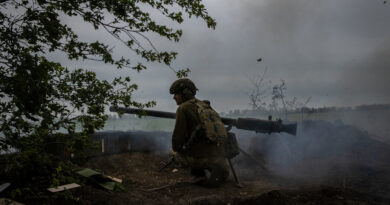Mexico’s ‘Monster’ Trucks Show Cartels Taking Drug War to Next Level
[ad_1]
In the United States, some truck owners delight in modifying their rigs with oversized wheels, heavy-duty suspension kits and soot-spewing exhaust systems, turning them into the monster trucks that stalk organized events like demolition derbies and mud bogs.
How quaint.
In Mexico, drug cartels are taking the monster truck concept to another terrifying level, retrofitting popular pickups with battering rams, four-inch-thick steel plates welded onto their chassis and turrets for firing machine guns.
Some of Mexico’s most feared criminal groups, including the Jalisco New Generation Cartel, are using the vehicles in pitched gun battles with the police. Other organizations, like the Gulf Cartel and the Northeast Cartel, use the armored trucks to fight each other.
Mexican security forces call these vehicles monstruos (monsters), but they are also known as rinocerontes (rhinos) and narcotanques (narco-tanks). Cartels emblazon the exteriors with their initials or the latest in camouflage patterns, at times making them hard to distinguish from official military vehicles.
Flashy interiors of larger trucks feature front seats with a cockpit-like array of buttons and lights, metal seats from where gunmen can lean their rifles through holes and, in the middle, a hatch similar to that of a tank.
As more trucks roll onto the streets of Mexico’s violent towns and cities, the vehicles serve as a prism to view the evolution of the country’s blood-soaked drug wars — whether with dread over the cartels’ capacity to outmaneuver efforts by the authorities to impose order or a grim recognition of the vehicles’ postapocalyptic “Mad Max” vibe.
The spread of the behemoths is more evidence that cartels will go to any length “to try to enforce by violent means their dominance against adversary gangs and against authority,’’ said Jorge Septién, a Mexico City-based expert on ballistics and armaments.
They also highlight the country’s sputtering efforts against brutal criminal groups that operate with seeming impunity in many parts of Mexico.
The armored trucks are among the more visible and intimidating enhancements to the lethal arsenal at the disposal of Mexico’s most powerful cartels, according to Romain Le Cour, a security analyst.
Other weapons and arms include steel-penetrating Barrett .50 caliber sniper rifles, rocket launchers and rocket-propelled grenades capable of shooting down military helicopters, drones fitted with remote-detonated explosives and roadside anti-vehicle mines, used in an attack last month in Jalisco that killed six people.
“The monsters are the way to send the message, ‘I’m in charge, and I want everyone to see I’m in charge,’” said Mr. Le Cour, senior expert at the Switzerland-based Global Initiative against Transnational Organized Crime. “These are commando-style groups looking to replicate special forces in how they’re armed, how they’re trained, how they look.”
While the trucks are thought to have emerged in Mexico a little more than a decade ago, they seem to be multiplying and growing more sophisticated, much in the way that narco-submarines built by criminal groups to transport drugs have adapted to elude capture.
The progression of the armored trucks has followed the flow of elite soldiers into cartels, starting with the recruitment in the 1990s of Mexican Army’s special forces into a paramilitary operation that became the Zetas cartel.
From the weapons they use to the vehicles they drive, the involvement of members of specialized military units in criminal organizations has led these groups to emulate and compete with the country’s elite forces.
The seizure of armored trucks helps shed light on regions where cartel operations are flourishing or resurgent, like in the states of Michoacán and Jalisco, on Mexico’s Pacific Coast or along the United States border.
In June, the federal attorney general’s office in the state of Tamaulipas, across the border from Texas, announced that it had captured and destroyed 14 monster trucks, following the destruction of 11 other similar vehicles in February.
The state prosecutor’s office in Tamaulipas, in a statement last year, cited the “danger to the safety of the community” posed by the modified vehicles, which criminal groups often use to guard their illegal activities, particularly near the border.
In Tamaulipas alone, more than 260 armored trucks were destroyed by the authorities since 2019. Providing a national figure is difficult because various federal and state agencies confiscate and demolish them.
The assembling of the vehicles, often in rural workshops, draws on the well-known skills of cartel mechanics who have long focused on modifying cars to smuggle hidden cargoes of drugs across borders.
Armoring a truck with the basics, like steel plates, takes 60 to 70 days, the work of five to six welders and mechanics and costs roughly two million pesos, or about $117,000, according to security experts. (Extra features like turrets, bulletproof tires and battering rams will run up the bill.)
While armoring a vehicle without authorization is a crime punishable by up to 15 years in prison, the law has done little to dent their robust production.
In Small Wars Journal, an American publication focusing on intrastate conflict, an analysis said “that such armored vehicles far outclass standard Mexican police armaments.”
The trucks are typically crafted from standard-issue pickups, but the analysis noted the use by cartels of heavily armored “dump truck variants” that are immune to all but the anti-vehicle weapons possessed by Mexico’s armed forces.
Monster trucks are often made from popular vehicles like the Ford Lobo (the equivalent of the Ford F-150 in the United States) or the Ford Raptor. But gangs also use sport-utility vehicles better known elsewhere for making runs to the suburban big box stores, like the bulky Chevrolet Tahoe, as well as larger flatbeds, dump trucks or heavy-duty “dually” trucks with two rear wheels on each side.
Underscoring the arms race between the cartels and Mexico’s armed forces, some Mexican soldiers now carry shoulder-fired rocket launchers capable of destroying armored trucks.
The trucks gained prominence in 2020, when a video that surfaced on social media showed the leader of the Jalisco New Generation Cartel, Nemesio Oseguera Cervantes — one of the most wanted men in Mexico and the United States — parading his private army on the border of the states of Michoacán and Guanajuato.
The show of force included several monster trucks, as well as camouflage-clad gunmen, their faces hidden behind balaclavas, firing weapons into the air as they shouted allegiance to Mr. Oseguera Cervantes.
Since then, the trucks have leaped into the public imagination. A video captured by a drone of an attack by the Jalisco New Generation Cartel against local police officers and residents using the trucks was shown on a national television network in 2021.
Despite their terrifying reputation, the trucks do have drawbacks. Unlike the fast-moving and nimble Toyota Hilux pickups mounted with machine guns used by armed groups in many parts of the world, monster trucks laden with steel plates can be sluggish and hard to maneuver, especially in urban settings.
“They’re too slow, too heavy,” said Alexei Chévez, a security analyst based in Cuernavaca, Mexico. And the retrofitting of the vehicles means that some of their parts malfunction. “We see them constantly breaking down and being abandoned,” Mr. Chévez said.
Still, their strategic and symbolic importance resonates in a country that has witnessed years of horrific violence perpetrated by criminal groups. The trucks often appear on TikTok and other social media, accompanied by narco rap songs or folk ballads extolling cartel exploits.
“It has to do with a status symbol,” Mr. Septién said. “The first ones we saw were practically blow-torched and welded in a very shoddy way.”
These days, he added, when approaching from a distance, “they look like a military vehicle.”
[ad_2]
Source link


